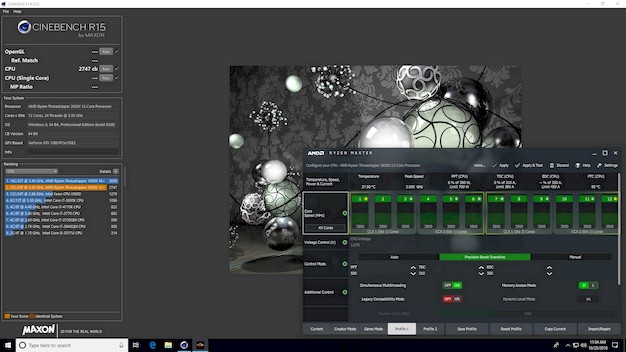AMD Ryzen Threadripper 2920X And 2970WX Review: Lower Cost, Many Core Beasts
We also spent some time overclocking the 2nd Generation AMD Ryzen Threadripper 2970WX and 2920X (sort of) to see what kind of additional horsepower they had lurking under their heat spreaders...
|
Manually overclocking a 2nd Generation Ryzen Threadripper processor is very similar to the original parts. Because the processors are unlocked, overclocking it is simply a matter of altering a few multipliers, tweaking voltages, and dealing with the additional heat and power requirements. These processors can also be overclocked by adjusting base clock frequencies though, so it's possible to really fine tune the end result if you like to tinker and go the manual route.
As was the case with the first-gen Threadrippers, overclocking can be done from within the BIOS on enthusiast motherboards or via AMD's Ryzen Master software. Ryzen Master gets another major update with this launch, however, that's probably going to be appealing to those of you that would like to maximize performance on a Threadripper, without sacrificing some of its more advanced features.
In addition to support for Dynamic Local Mode, the latest version of Ryzen Master -- version 1.5 -- includes these important overclocking features related to 2nd Gen Threadrippers that were first introduced in v1.4...
- Precision Boost Overdrive (PBO): PBO allows the SoC to consume more power from the socket, and exploits additional current headroom in motherboards with VRM configurations that exceed AMD specification.
- Topology View: Cores in the UI are now labeled and grouped according to their physical location in the SoC.
- Quarter Core Mode: Legacy Compatibility Mode has been extended to include a 75% thread count reduction.
Precision Boost Overdrive, or PBO, will be particularly interesting to budding Threadripper overclockers. When manually overclocking Ryzen and Ryzen Threadripper processors, you lose support for Precision Boost and essentially lock the processors at a given max frequency, which may actually be lower than the maximum single-core Precision Boost frequency, so you end up losing some single-threaded performance. With PBO, however, frequencies are dynamically adjusted and automatically managed -- SenseMI is left in control of the processor -- and Precision Boost continues to function. PBO also reads data embedded in the BIOS by motherboard manufacturers that outlines the maximum power limits of that particular board. Simply flip on PBO in Ryzen Master, crank up the power targets in-line with your motherboard's capabilities and your system's cooling, and bingo -- you've increased system performance.
Because PBO is so easy to use and maintains the processors' feature set when enabled, and will likely be the most popular overclocking method for these CPUs, we used it for our overclocking tests. This is a somewhat conservative approach to overclocking a Threadripper and should give you all an idea as to the “worst case scenario” overclock that just about anyone can expect. Our results should be repeatable, assuming you’ve got similar hardware and everything is working properly. Cooling duties were handled by a Thermaltake 360mm AiO liquid cooler.
To see what our chips could do, we enabled PBO and increased the power targets to the maximum values available with our motherboard that didn't result in any unexpected throttling or lower-than-expected performance (these values will vary from board to board depending on the robustness of its VRM and VRM cooling solution). During our endeavor, we should note that the processors operated in the 80-degree range when under sustained load, and idle temperatures hovered in the upper 30s, so temps were not an issue at all. Maxing out the values, however, sometimes resulted in lower performance. Finding the ideal balanced values will differ from configuration to configuration.


While we had PBO enabled, we re-ran a couple of benchmarks and saw some nice performance improvements. We broke 4,600 in Cinebench's MT test with the Threadripper 2970WX and the 12-core 2920X inched closer to the 16-core Threadripper 1950X. The 3DMark Fire Strike Physics test also showed some gains for both chips, though the highest marks from the 2970WX were achieved in 1/2 core legacy compatibility mode, so it's not quite as exciting.
|
Throughout all of our benchmarking and testing, we also monitored how much power our 2nd Gen Ryzen Threadripper test system was consuming with a power meter, versus the other systems we used for benchmark comparisons.
Our goal was to give you an idea as to how much power each configuration used while idling at the Windows desktop and while under a heavy CPU workload. Keep in mind, this is total system power consumption being measured at the outlet and not the the individual power of the CPUs alone.

In our initial tests, idle power consumption was somewhat high with the 2nd Gen Threadrippers. Although we tested the 2970WX and 2920X in the exact same rig, with all of the same hardware, they offered somewhat lower idle power -- we suspect the latest version of Ryzen Master compatible with the 2970WX / 2920X or AMD's platform drivers made some changes, so we'll have to go back and re-test the original chips. Load power is in-line with expectations, with the 2970WX consuming slightly less power than the 2990WX and the 2920X slotting in just behind the 2950X.


We also monitored power while overclocking and saw some huge jumps in consumption. While overclocked, the Threadripper 2920X's peak power consumption under load jumped up by over 60 watts. The Threadripper 2970WX's power increased by 160 watts, and as we mentioned earlier, that wasn't even with the power targets cranked all the way up to their absolute maximums. Moral of the story -- make sure you've got a robust motherboard, a good power supply, and a beefy cooler if you plan to overclock a Threadripper, especially a quad-die Threadripper like the 2970WX.









